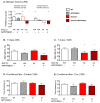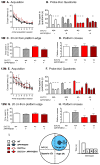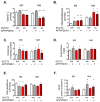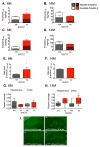Vitamin C deficiency in the brain impairs cognition, increases amyloid accumulation and deposition, and oxidative stress in APP/PSEN1 and normally aging mice
- PMID: 25642732
- PMCID: PMC4476071
- DOI: 10.1021/cn500308h
Vitamin C deficiency in the brain impairs cognition, increases amyloid accumulation and deposition, and oxidative stress in APP/PSEN1 and normally aging mice
Abstract
Subclinical vitamin C deficiency is widespread in many populations, but its role in both Alzheimer's disease and normal aging is understudied. In the present study, we decreased brain vitamin C in the APPSWE/PSEN1deltaE9 mouse model of Alzheimer's disease by crossing APP/PSEN1(+) bigenic mice with SVCT2(+/-) heterozygous knockout mice, which have lower numbers of the sodium-dependent vitamin C transporter required for neuronal vitamin C transport. SVCT2(+/-) mice performed less well on the rotarod task at both 5 and 12 months of age compared to littermates. SVCT2(+/-) and APP/PSEN1(+) mice and the combination genotype SVCT2(+/-)APP/PSEN1(+) were also impaired on multiple tests of cognitive ability (olfactory memory task, Y-maze alternation, conditioned fear, Morris water maze). In younger mice, both low vitamin C (SVCT2(+/-)) and APP/PSEN1 mutations increased brain cortex oxidative stress (malondialdehyde, protein carbonyls, F2-isoprostanes) and decreased total glutathione compared to wild-type controls. SVCT2(+/-) mice also had increased amounts of both soluble and insoluble Aβ1-42 and a higher Aβ1-42/1-40 ratio. By 14 months of age, oxidative stress levels were similar among groups, but there were more amyloid-β plaque deposits in both hippocampus and cortex of SVCT2(+/-)APP/PSEN1(+) mice compared to APP/PSEN1(+) mice with normal brain vitamin C. These data suggest that even moderate intracellular vitamin C deficiency plays an important role in accelerating amyloid pathogenesis, particularly during early stages of disease development, and that these effects are likely modulated by oxidative stress pathways.
Keywords: Alzheimer’s disease; Vitamin C; amyloid; cognition; mouse models; oxidative stress.
Conflict of interest statement
Figures






Similar articles
-
Mitochondrial dysfunction in the APP/PSEN1 mouse model of Alzheimer's disease and a novel protective role for ascorbate.Free Radic Biol Med. 2017 Nov;112:515-523. doi: 10.1016/j.freeradbiomed.2017.08.021. Epub 2017 Aug 31. Free Radic Biol Med. 2017. PMID: 28863942 Free PMC article.
-
Low brain ascorbic acid increases susceptibility to seizures in mouse models of decreased brain ascorbic acid transport and Alzheimer's disease.Epilepsy Res. 2015 Feb;110:20-5. doi: 10.1016/j.eplepsyres.2014.11.017. Epub 2014 Nov 26. Epilepsy Res. 2015. PMID: 25616451 Free PMC article.
-
Intravenous ascorbate improves spatial memory in middle-aged APP/PSEN1 and wild type mice.Behav Brain Res. 2014 May 1;264:34-42. doi: 10.1016/j.bbr.2014.01.044. Epub 2014 Feb 5. Behav Brain Res. 2014. PMID: 24508240 Free PMC article.
-
The SAMP8 mouse: a model to develop therapeutic interventions for Alzheimer's disease.Curr Pharm Des. 2012;18(8):1123-30. doi: 10.2174/138161212799315795. Curr Pharm Des. 2012. PMID: 22288401 Review.
-
Learning and memory deficits in APP transgenic mouse models of amyloid deposition.Neurochem Res. 2003 Jul;28(7):1029-34. doi: 10.1023/a:1023255106106. Neurochem Res. 2003. PMID: 12737527 Review.
Cited by
-
Parenteral high‑dose ascorbate - A possible approach for the treatment of glioblastoma (Review).Int J Oncol. 2021 Jun;58(6):35. doi: 10.3892/ijo.2021.5215. Epub 2021 May 6. Int J Oncol. 2021. PMID: 33955499 Free PMC article. Review.
-
Diet Associated with Inflammation and Alzheimer's Disease.J Alzheimers Dis Rep. 2019 Nov 16;3(1):299-309. doi: 10.3233/ADR-190152. J Alzheimers Dis Rep. 2019. PMID: 31867568 Free PMC article. Review.
-
Shared Neuropathological Characteristics of Obesity, Type 2 Diabetes and Alzheimer's Disease: Impacts on Cognitive Decline.Nutrients. 2015 Sep 1;7(9):7332-57. doi: 10.3390/nu7095341. Nutrients. 2015. PMID: 26340637 Free PMC article. Review.
-
A bibliometric review on vitamins and Alzheimer's disease between 1996 and 2023.Front Aging Neurosci. 2023 May 11;15:1144804. doi: 10.3389/fnagi.2023.1144804. eCollection 2023. Front Aging Neurosci. 2023. PMID: 37251810 Free PMC article.
-
Does Vitamin C Influence Neurodegenerative Diseases and Psychiatric Disorders?Nutrients. 2017 Jun 27;9(7):659. doi: 10.3390/nu9070659. Nutrients. 2017. PMID: 28654017 Free PMC article. Review.
References
-
- Pratico D, Clark CM, Liun F, Rokach J, Lee VY, Trojanowski JQ. Increase of brain oxidative stress in mild cognitive impairment: a possible predictor of Alzheimer disease. Archives of neurology. 2002;59(6):972–6. - PubMed
-
- Pratico D, Sung S. Lipid peroxidation and oxidative imbalance: early functional events in Alzheimer's disease. J Alzheimers Dis. 2004;6(2):171–5. - PubMed
-
- Morris MC, Beckett LA, Scherr PA, Hebert LE, Bennett DA, Field TS, Evans DA. Vitamin E and vitamin C supplement use and risk of incident Alzheimer disease. Alzheimer disease and associated disorders. 1998;12(3):121–6. - PubMed
-
- Morris MC, Evans DA, Bienias JL, Tangney CC, Bennett DA, Aggarwal N, Wilson RS, Scherr PA. Dietary intake of antioxidant nutrients and the risk of incident Alzheimer disease in a biracial community study. Jama. 2002;287(24):3230–7. - PubMed
Publication types
MeSH terms
Substances
Grants and funding
LinkOut - more resources
Full Text Sources
Other Literature Sources
Medical
Molecular Biology Databases
Miscellaneous

